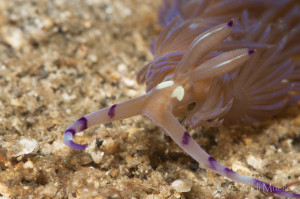Searching for nudibranchs can be like a treasure hunt (with the greatest reward being to show your buddy a cool one before they’ve seen it), and their beautiful colors make them a favorite for underwater photographers. But here is another reason why nudibranchs are so cool: meet Pteraeolidia ianthina, commonly called the blue dragon nudibranch. Here’s the cool thing: it runs on solar power.
Long before humans discovered the potential to convert the sun’s light into energy, the blue dragon was doing just that. This aeolid nudibranch, commonly found from Hawaii to Australia throughout the Indo-Pacific, feeds on hydroids. Hydroids house zooxanthellae, a microscopic marine plant, which in turn, is also eaten by the nudibranch. The blue dragon is able to keep these zooxanthellae in its body and, just as the hydroid did, the nudibranch benefits from the plant’s photosynthesis.
Related to corals, hydroids are stinging organisms. The hydroids and zooxanthellae have a symbiotic relationship, wherein they both benefit. Zooxanthellae, like all plants, use the sunlight to make sugars and the hydroids benefit from this and are able to use some of those sugars. The zooxanthellae also benefit by having a safe place to live.

Once consumed by blue dragon nudibranchs, the zooxanthellae are able to pass through the nudibranchs’ digestive system and, after being extracted from the hydroids, they can survive in the nudibranch. They are stored in the feathery-looking extensions coming out of the nudibranch’s body, called cerata. Blue dragons and other nudibranchs can do a similar process with the stinging cells from the hydroids. Their digestive system extends into the cerata, and the stinging cells can pass through to the ends. Here they can be used as a defense mechanism against predators by making them poisonous or at least really bad-tasting.
Inside the nudibranch, the zooxanthellae continue to produce energy from photosynthesis and the nudibranch uses the end product, sugar. The numerous cerata likely evolved to extend and be frilly so that there is a lot of surface space for the zooxanthellae to live, and greater surface area to collect sunlight. It’s possible that with a good stock of zooxanthellae, the nudibranch may not need to eat for an extended time.
Depending on the type of hydroid and how much or how little they are eating, the blue dragon’s colors can vary from ivory to a beautiful blue or purple. Juveniles are white until they have started storing zooxanthellae. Found from 6 to 180 feet, they are most commonly more shallow because more sunlight can penetrate. The blue dragon is one of the more common nudibranchs and easy to find if their bright purple frills stand out. They can also be quite large, 3 to 4 inches long.
So the next time your dive guide points out a blue dragon, take a closer look at fancy frilly cerata and remember they’re not just for good looks. And that nudibranchs are even cooler than you thought they were.
Guest blog by Brandi Mueller

